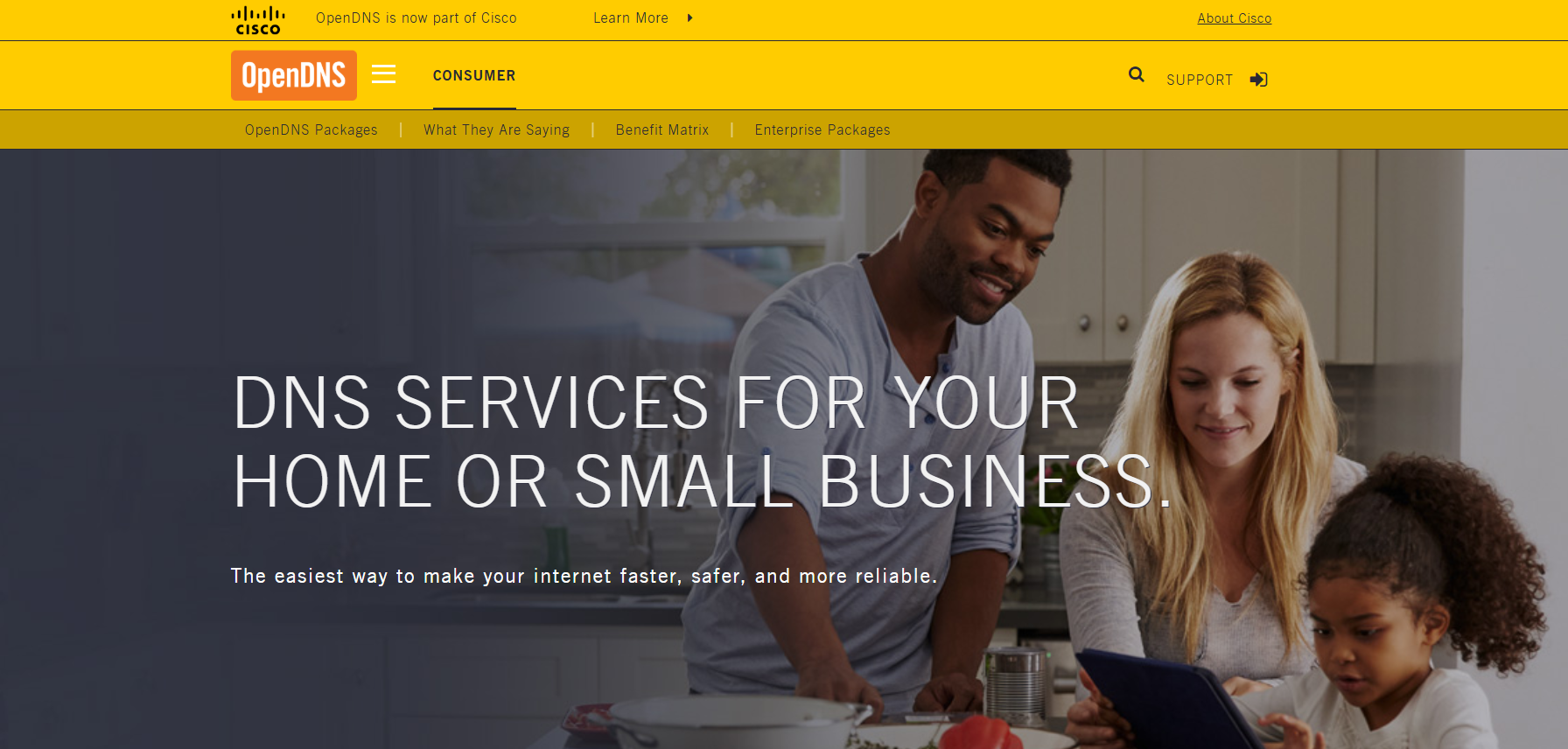Why you can trust TechRadar
We spend hours testing every product or service we review, so you can be sure you’re buying the best. Find out more about how we test.
OpenDNS is a cloud-based Domain Name System (DNS) provider that delivers enhanced security with web filtering and various blocking features – and OpenDNS Family Shield is its consumer product for protecting entire households from inappropriate content on the internet. So while it isn’t a fully fledged parental control app, it does offer some similar functions.
Family Shield is designed to offer fast, easy parental control – the kind of product where parents can set it up once and forget about it, knowing that it’ll block adult content on all devices. It’s easy to use, but doesn’t include customization.
OpenDNS also has a free product called OpenDNS Home, which allows parents to customize their web filtering and view basic usage stats. It’s more involved, but trickier to set up.
Since 2015, OpenDNS has been part of the Cisco organization, so there’s no shortage of cloud computing and cybersecurity knowledge underpinning this tool.
Plans and pricing
Family Shield gets off to a pleasing start – because it’s entirely free, just like the customizable Home product.
Despite that free status, Family Shield covers an unlimited number of devices, and it doesn’t require an account to use – unlike the free Home product, which requires account creation in order to use its customization abilities.
Features
Family Shield is free, then, but what does it do? Put simply, it’s a preconfigured web filter that you can set up on your router, PC, smartphone or server. Once it’s configured, it blocks potentially harmful traffic.
The best way to use OpenDNS is to set it up on your router – that way, it’ll filter all the traffic that goes through your router, whether that’s from phones, games consoles, laptops or anything else.
Family Shield’s preconfigured filter blocks content in four categories: pornography, tasteless, proxy/anonymizer, and sexuality. You’ll find virtually everything you don’t want your children seeing within those four categories. On top of that, OpenDNS Family Shield also blocks phishing sites and other potentially dangerous websites.
The filter works extremely well, and the fact it works on routers means it works across a broader range of devices than most parental control tools.
Bear in mind, though, that more conventional tools like Qustodio or MMGuardian allow you to filter using a far wider array of categories.
If you want a wider array of categories or if you want to add your own permitted or blocked sites to lists, then you’ll have to use OpenDNS Home – a more customizable product that’s admittedly a bit more technical.
Once Family Shield is configured, there’s no dashboard, control panel or app to worry about – you apply the settings and let it work.
It couldn’t be easier, then, but it’s worth noting that OpenDNS Family Shield is a filter, not a conventional parental control app, so you miss many features you’ll find elsewhere.
You won’t find screen time controls, location monitoring, app blocking or anything else here, for instance – because OpenDNS Family Shield is simply not that kind of product.
If you want those, you’ll have to explore a free tool from Microsoft, Google or Mobicip, or a paid product like Norton Family Safety, Qustodio or Bark.
Interface and use
The most effective way to use OpenDNS Family Shield is by setting it up on your router – that way, it filters all of the web traffic that goes through the router across your array of devices.
To set up Family Shield on your router, you’ll have to go into your router’s browser settings and alter its DNS settings – the numbers that control how web traffic flows through the router. Once those settings are saved, web traffic is routed through OpenDNS’s filters, which means inappropriate sites are blocked.
The process will likely be almost identical for most routers, but OpenDNS provides dozens of useful guides, with pictures, for many common models.
That’s great, although people who aren’t technically savvy may still struggle to set OpenDNS Family Shield up because they’re unsure about delving into router or device networking settings – and that’s entirely understandable.
If you want to install OpenDNS filtering on individual devices, like smartphones, then it’s just as easy – and this is an effective way to apply filtering on technology that won’t always be connected to the internet through your home router.
On Android and iOS, it’s as simple as heading to the network settings and changing the DNS configuration. On Windows and macOS, it’s a similar process. And for a huge variety of devices, from phones and games consoles to Linux laptops and Windows devices, OpenDNS provides clear tutorials.
If you want to use OpenDNS Home instead, setup is largely similar – and you can use a web-based dashboard to manage your network, alter filters, and view statistics about network usage.
Support
We’ve already mentioned the wealth of setup guides you can use with OpenDNS Family Shield, and support is comprehensive elsewhere. The Documentation section is full of guides that take a deeper look at OpenDNS technology, and you can delve into configuration if you’d like to use OpenDNS Home instead.
The user forum is extremely busy, so it should be relatively easy to get answers to common technical issues, and there’s a ticket-based system for submitting support requests. Reports online suggest that replies are both quick and helpful.
The only thing missing here is phone support or live chat, but that tends to be offered by larger organizations with parental control apps that have more features. While OpenDNS is certainly a huge company, Family Shield is a relatively basic filter rather than a fully-featured parental control app.
The competition
That status means that it’s quite difficult to weigh up OpenDNS Family Shield with any close rivals – because this web filtering product is unique.
It does a great job of filtering your network, for instance, but you’ll also find excellent filtering in Qustodio and MMGuardian – albeit on individual devices. Both of those products, and Bark, also provide a broader slate of parental control features, even though they are paid-for products.
And if you want parental control without paying a penny, then shop around: Microsoft Family Safety and Google Family Link both have basic filtering, and Qustodio offers a free parental control app for single-device monitoring.
Final verdict
There’s no doubt that OpenDNS Family Shield is an excellent web filter. When applied to your router, it’ll do a tremendous job of blocking inappropriate traffic across every device in your home – and all for free.
When used on smartphones and laptops, it’ll block those same websites when children are using other networks, too, and OpenDNS Home is an ideal next step for customization if you’re comfortable with more technical setup and customization.
Beyond the filter, though, OpenDNS Family Shield has little to offer because it’s not a full parental control suite.
If you’re happy with using a filter on your networks, then Family Shield is a free and effective option. But if you want parental control features like location tracking, screen time restrictions and app control, then you’ll have to look elsewhere – and maybe spend some money, too.
Read the full article here















